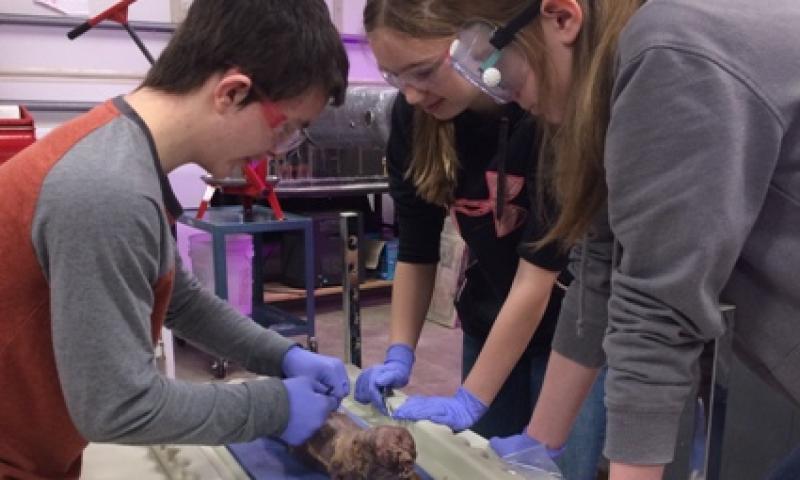
(Photo Above: James Cole, Jenna Fisher, and Alivia Gubbels dissect minks during Introduction to Agriculture. The students are learning about muscle identification.)
A random day in February, a pink glow from the hydroponics room lights up the shop windows before the day starts. The day will be full of career pathways focusing on plants, animals, and natural resources with a few life lessons thrown in along the way.
At about 7:00 am, eight FFA officers start straggling in before school to discuss plans for upcoming FFA events. These officers are in charge of the busy schedule of the FFA. They are learning the positives and negatives of how to work together and the planning that it takes to be leaders. Then a few students start to arrive to feed the fish and collect data for their science experiments.
The first period starts sharply at 8:00 am. This diverse class, called Introduction to Agriculture, has freshmen through juniors in it. A daily work question reviewing swine production begins the class. After the majority of students answer the question on their Chromebooks and the few students that are still learning about time management feel the positive pressures of the majority of students, a lecture on swine production continues from the day before. The students use their vocabulary about the swine unit to a mink dissection that applies anatomy concepts to livestock production.
Next, the second-period Natural Resources class strolls in and goes straight to the shop to check on their Biodiesel production. This group of Juniors and Seniors are experimenting on how different natural oils ranging from used cooking oil to the leftover grease from a smoker grill can be turned into biodiesel.
Mid-morning, the third period Agriculture Biology grudgingly comes into an applied biology course that teaches the principles of biology with agricultural examples. The class is learning about dihybrid crosses and pedigree charts. Somehow the students also have to juggle developing an AgriScience Lab Report about everything from the greening of potatoes to the decomposition of drinking straws.
The fourth period seems to come and go fast. These students get the smells of the different livestock bowels. The students identify the differences of monogastric and polygastric digestive tracts by dissecting the organs of a calf that didn’t make it and a market gilt donated Tyson.
These smells switch to flowers without skipping a beat. The FFA is selling carnation flowers in the forum. The members give up their lunchtime to sell a few flowers to raise money. The members need to raise money to help cover costs to compete in contests, offset registration fees to conferences, hotels, meals, and community service experiences.
The day continues after lunch with Dual-Credit Animal Science students learning how to handle swine. The one student uses a sorting board to calmly corner a 22-pound piglet and another student quickly and safely picks up the little gilt or barrow. Other students weigh, take an infrared temperature photo, and even take the heart rate of the piglet to collect data for their science experiment about swine behavior.
The day almost ends with an Extra Learning Opportunity. Some students come into the classroom to take advantage of the reassessment opportunity. A couple of students come in for extra help on classroom materials and a few students are finishing up some data collections by weighing their dehydrated oranges.
As the bell rings to end the day, one student stays after to get help on their upcoming FFA application. A couple of others stick around to clean up some messes that didn’t get cleaned throughout the day. Then the lights of the shop shut off and the pink glow of the hydroponic lights recapture the classroom till the next day.
Written by FFA Director and Ag Teacher Mr. Jonathan Anderson and some of his Ag Students
